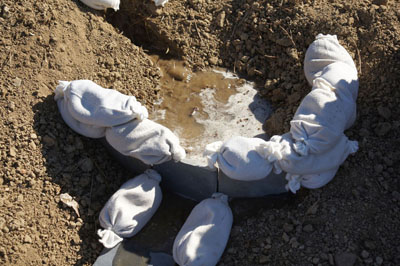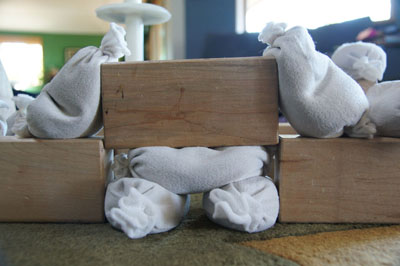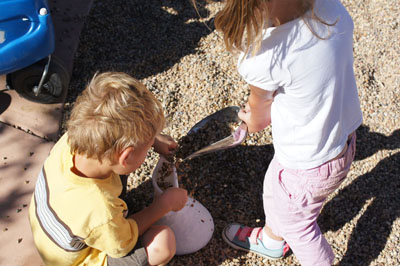As you may know, last week here in Colorado the Heavens let loose a torrent of rain. For over 5 days Boulder and surrounding areas received 17 inches of rain, 9 of which fell in one day. Our yearly average is 20.68 inches so, needless to say, our communities have a lot a cleanup and rebuilding to do! So many children in our area were affected by this “100 year” flood. Some, of course, more than others, but everyone experienced this mass amount of rain. We heard children asking questions, posing concerns, and working through these thoughts in their play here at school. Providing children the support, space and time to play is very important in helping them understand such complex realities.
Not to make light of our current situation here in Colorado, but the children here have been using the sandbags more than normal this week and we are inspired! Our Small and Large Sandbags offer children variety when creating structures while at work in the sandbox, at the water flume or gutter system, and even indoors in the block space.
There are the obvious uses such as building dams, but sandbags have versatility far beyond holding water. Filling the bags with sand, gravel or other material is a dexterity challenge and often results in great teamwork. Attaching the closure ties is a challenging fine motor task while lifting the Large bags is a strength building delight. The soft malleable bag in the block area offers new challenges and your ramps have never had the support a sandbag can offer.
Sandbag work contributes to understanding Engineering and Physical Science concepts. Interlocking patterns add to the strength of a wall or other structure. Bricklayers use this technique. Challenge the children to build a curved wall with the sandbags. How does interlocking help? Identify where we find patterns like this in the school, the community? Can we build similar structures with Lego bricks or standard unit blocks? Ask what ways the patterns affect the strength or flexibility of a structure.
 Water, we know, is a powerful force and can be difficult to control. Children can use sandbags to help change the course of water causing it to shift direction, flow slowly or quickly, and make buoyant materials spin, swirl or travel. Building dams and shores in your sandbox, water flume or gutter system are ways children play with and test their theories, designs, and suppositions about structures that affect water. With older children, you might suggest they construct plans and build models of structures that help reduce erosion or transport water for farming. Challenge them to move the water from one side of the sandbox (the mountain reservoir) to the other (the farm fields). With young children, we believe that supplying a bin full of boats, leaves or corks and a pile of Small or Large Sandbags is all you need to ignite their interest in your water play area.
Water, we know, is a powerful force and can be difficult to control. Children can use sandbags to help change the course of water causing it to shift direction, flow slowly or quickly, and make buoyant materials spin, swirl or travel. Building dams and shores in your sandbox, water flume or gutter system are ways children play with and test their theories, designs, and suppositions about structures that affect water. With older children, you might suggest they construct plans and build models of structures that help reduce erosion or transport water for farming. Challenge them to move the water from one side of the sandbox (the mountain reservoir) to the other (the farm fields). With young children, we believe that supplying a bin full of boats, leaves or corks and a pile of Small or Large Sandbags is all you need to ignite their interest in your water play area.
Real World Connections
We know that one way young children learn is to make connections between the materials they use at school and real life applications of similar materials. Construction workers often use sandbags to make temporary retaining walls and to fortify structures undergoing modification. Our Small Sandbags are perfectly sized (about 6″ long and 2″ diameter) for use with small classroom construction materials like unit blocks and table builders. Photos and picture books of worldwide construction sites will often be enough to cause children to think about their structures in new ways. We know that adding Small Sandbags will inspire dramatic play, provide new challenging opportunities and add that touch of something special to your block area. Look to your method of Social Studies Assessment for ways children are making connections to the jobs people do and the types of structures we build in our cities, towns and rural communities.
Weight and Counterweight
Use the Large Sandbags (about 12″ long by 5″ diameter) in combination with your current playground pulley and bucket system. (We hope you have one!) This is similar to the work that stagehands use when lifting large pieces of scenery in theatrical productions and how ranchers move bales of hay from the loft to the barn floor and vise-versa. Your children may identify other contextual references with sand bags and pulley systems, for instance the local loading docks, shipyard or marina may use them. When children explore the concepts of using weights and counterweights, they’re not only thinking about cause and effect and spatial relationships but will gain understanding about direction, weight, resistance and balance. Our sandbags are perfect for this work.
Questions To Ask:
 How are sand bags like bean bags, sleeping bags, paper bags? How are they different? Compare the look, feel and smell of wet and dry sandbags. How many scoops fit into the Smalls and the Larges? How many can we stack before they topple over? Do wet ones stack higher? Are they heavier? Why? How can we use sand bags like we use building bricks or unit blocks? Although we’re not looking for the “right” answers, we often think of the sandbags as a tool children use while adults make observations, model inquiry and ask questions that lead children to think deeper, build bigger and make connections.
How are sand bags like bean bags, sleeping bags, paper bags? How are they different? Compare the look, feel and smell of wet and dry sandbags. How many scoops fit into the Smalls and the Larges? How many can we stack before they topple over? Do wet ones stack higher? Are they heavier? Why? How can we use sand bags like we use building bricks or unit blocks? Although we’re not looking for the “right” answers, we often think of the sandbags as a tool children use while adults make observations, model inquiry and ask questions that lead children to think deeper, build bigger and make connections.
Some suggested vocabulary words:
- Levee, dam, fortify, flood
- Flow, drain, stream
- Weight, counterweight, ballast
- Structure, interlock, stagger
We hope this sparks ideas for sandbag exploration throughout various areas of your classroom and center.


